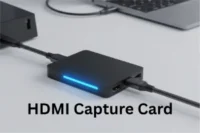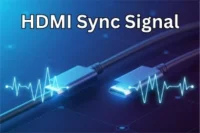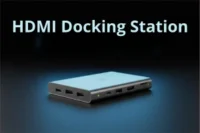Convert HDMI to DisplayPort: Quick and Easy Guide
Published: 27 Oct 2025
In the world of modern connectivity, HDMI to DisplayPort has become a popular topic, especially for those who often deal with multiple devices and varying display technologies.
Even though HDMI and DisplayPort are well-known and widely used standards, connecting them directly is not always simple. Many users assume that an HDMI to DisplayPort connection is as straightforward as using a simple cable.
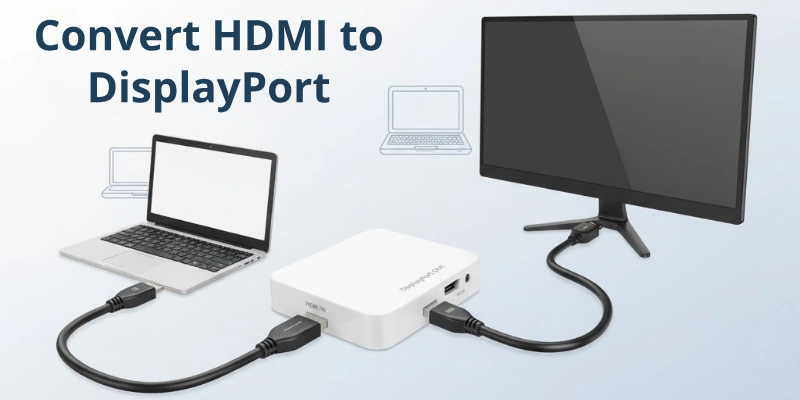
However, that’s a common misconception. The reality is, HDMI and DisplayPort work differently in terms of signal transmission, which makes the conversion between them a bit more technical.
This guide is specifically created to clear all doubts related to HDMI to DisplayPort connections.
If you are planning to connect an HDMI output device to a DisplayPort input monitor or screen, understanding the process, challenges, and proper solutions is essential.
Can You Convert HDMI to DisplayPort Directly?
Many people wonder — Can I just use a simple cable to connect HDMI to DisplayPort? The short and straight answer is NO. The reason is very simple: both HDMI and DisplayPort send and receive signals in different ways.
HDMI sends out a signal that DisplayPort cannot read directly. That’s why connecting an HDMI device like a laptop, gaming console, or computer to a DisplayPort monitor needs something special — it needs signal conversion.
This is where an HDMI to DisplayPort adapter comes in. But not just any adapter — it has to be an active adapter. Active adapters have a small built-in chip that converts the signal from HDMI to DisplayPort so that both devices can communicate properly.
Without this conversion, a simple HDMI to DisplayPort cable will not work. So always remember: if your device is sending out an HDMI signal and your screen has only DisplayPort input — you must use an active HDMI to DisplayPort adapter.
How HDMI to DisplayPort Adapters Work?
Now that we know a normal cable won’t work, let’s understand how HDMI to DisplayPort adapters actually work.
Think of an HDMI to DisplayPort adapter like a small translator sitting between two people who speak different languages. HDMI and DisplayPort signals are like two different languages. Your adapter’s job is to convert the HDMI signal into a format that DisplayPort can understand.
This special job is done by a tiny chip inside the adapter. This chip takes the HDMI signal, changes it into a DisplayPort signal, and then sends it to your monitor.
Why Some HDMI to DisplayPort Adapters Need Extra Power?
Sometimes this signal conversion needs more energy to work properly. That’s why many HDMI to DisplayPort adapters come with a USB cable attached. This USB connection gives the adapter extra power so that it can handle high-quality video or audio without any problem.
Without this extra power, some adapters might not work at all — especially if you are trying to run higher resolutions like 1080p or 4K.
In Short:
- HDMI and DisplayPort speak different signal languages.
- HDMI to DisplayPort adapters translate that signal.
- Most of these adapters need external power (via USB) for stable performance.
Scenarios Where You Need HDMI to DisplayPort
You might be thinking — “Do I really need an HDMI to DisplayPort adapter?” Let me explain some common real-life situations where people often need this converter.
1. Connecting Older Laptops to New Monitors
Many old or budget laptops only have an HDMI port for video output. But modern monitors, especially gaming or professional displays, often come with DisplayPort as their main input. In this case, an HDMI to DisplayPort adapter becomes the only solution to connect both devices.
2. Gaming Consoles to High-Quality Monitors
If you have a gaming console like:
- PlayStation
- Xbox
- Nintendo Switch
…these devices usually have HDMI output only. But what if your monitor supports DisplayPort for higher refresh rates or better resolution? Again, an HDMI to DisplayPort adapter is the answer.
3. Office Setups with Multiple Screens
In offices or work-from-home setups, people sometimes use multiple monitors. Some docking stations or work monitors have DisplayPort inputs only. If your laptop has HDMI output, you’ll need an HDMI to DisplayPort adapter to extend or mirror your screen.
4. Situations Where DisplayPort is the Only Option
Some professional monitors or video equipment do not support HDMI at all. In such cases, using an HDMI to DisplayPort adapter is not just useful — it becomes a must-have.
In all these situations, HDMI to DisplayPort adapters help connect devices easily without changing your hardware.
Limitations of HDMI to DisplayPort Adapters
Now before you buy an HDMI to DisplayPort adapter, it’s very important to know its limitations.
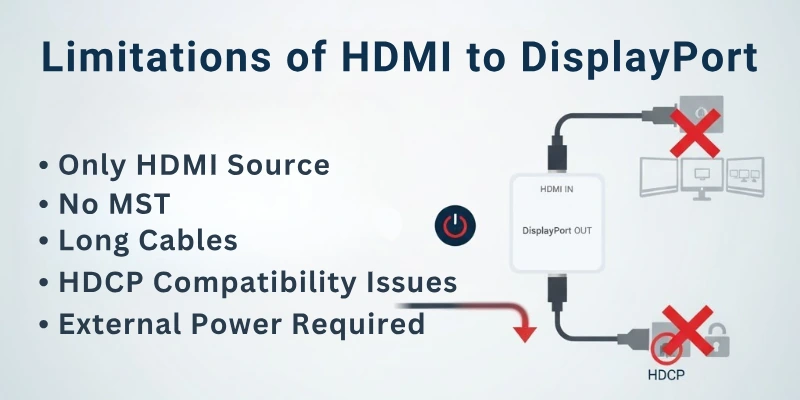
Yes, these adapters are super helpful — but they also have a few restrictions you should know.
1. Resolution & Refresh Rate Limits
Most HDMI to DisplayPort adapters support:
- 1080p at 60Hz (Full HD)
- Some support 4K, but usually at only 30Hz (not 60Hz)
This means, if you want 4K at 60Hz or very high refresh rates like 120Hz or 144Hz — many adapters may not support it unless they are premium or specially designed.
2. Audio Pass-through Might Not Work
Some HDMI to DisplayPort adapters only send video — and don’t transfer audio. So, if you want sound from your monitor, check the product details carefully before buying.
3. HDCP Issues (Copyright Protection)
HDCP is a content protection technology used by Netflix, Amazon Prime, etc. Some cheap HDMI to DisplayPort adapters cannot handle HDCP properly — which means you might face a black screen while streaming protected content.
4. Not Compatible with G-Sync or FreeSync
If you are a gamer using G-Sync or FreeSync for smoother gaming, most HDMI to DisplayPort adapters don’t support these advanced features.
Quick Recap:
- Check resolution & refresh rate support.
- Confirm if audio is supported.
- Be careful about HDCP restrictions.
- Don’t expect gaming features like G-Sync to work.
Things to Consider Before Buying HDMI to DisplayPort Adapter
Before you spend money on an HDMI to DisplayPort adapter, here are some important things you should check. This will help you avoid wasting money on the wrong product.
1. Active vs Passive Adapter
Always go for an active HDMI to DisplayPort adapter.
→ Why?
Because only active adapters can convert the HDMI signal properly for DisplayPort monitors. Passive adapters usually work the other way (DisplayPort to HDMI), not HDMI to DisplayPort.
2. Power Source
Check if the adapter needs extra power (usually through a USB connection).
→ Tip: If your device has low power output, get an adapter with a USB power option for stable performance.
3. Supported Resolution & Refresh Rate
Always read the product details carefully and look for:
- 1080p at 60Hz (basic standard)
- 4K support (if needed)
- Refresh rate limit (important for gamers)
4. Audio Support
Not all HDMI to DisplayPort adapters send audio signals. So, if you want sound through your monitor, buy an adapter that clearly says “Audio Supported”.
5. Brand Reputation & Reviews
Avoid cheap, unbranded adapters. Look for trusted brands and read customer reviews. A good HDMI to DisplayPort adapter is worth investing in for long-term use.
Quick Buying Checklist:
- Active adapter only
- USB power option (recommended)
- Resolution & refresh rate support
- Audio support
- Trusted brand & good reviews
Best HDMI to DisplayPort Adapters You Can Buy
There are many HDMI to DisplayPort adapters available in the market. But not all of them work well. To save your time and help you pick the right one, here are some of the best and trusted options that most users recommend.
Note: I am not promoting any specific brand — this list is based on popularity, performance, and customer reviews.
1. Cable Matters Active HDMI to DisplayPort Adapter
Best for: Regular use, office work, basic gaming.
Key Features:
- Supports 1080p @ 60Hz
- USB-powered for extra stability
- Audio pass-through support
- Trusted and well-known brand
2. StarTech Active HDMI to DisplayPort Adapter
Best for: Professional setups & multi-monitor use.
Key Features:
- Supports up to 4K @ 30Hz
- USB-powered
- Supports audio
- Known for high-quality adapters
3. Benfei Active HDMI to DisplayPort Adapter
Best for: Budget-friendly users.
Key Features:
- Supports 1080p @ 60Hz
- USB-powered
- Compact & easy to use
- Affordable pricing
4. FOINNEX Active HDMI to DisplayPort Adapter
Best for: Casual users & home use.
Key Features:
- Supports 1080p @ 60Hz
- USB-powered
- Audio supported
- Good customer reviews
My Expert Advice:
If you want long-term performance and stability, always choose a trusted brand when buying an HDMI to DisplayPort adapter. Never go for very cheap, unbranded products — they might not work properly or last long.
How to Connect HDMI to DisplayPort (Step-by-Step Guide)
Let me now explain how you can easily connect your HDMI device to a DisplayPort monitor using an HDMI to DisplayPort adapter.
Follow these simple steps:
Step 1: Buy the Right Adapter
- Make sure you have an active HDMI to DisplayPort adapter (not passive).
- Check for USB power if needed.
Step 2: Connect HDMI Cable
- Take an HDMI cable and connect one end to your device (like laptop, gaming console, or PC).
- Connect the other end to your HDMI to DisplayPort adapter.
Step 3: Connect DisplayPort Cable
- Now take a DisplayPort cable and connect it to your monitor.
- Attach the other end to your adapter’s DisplayPort output.
Step 4: Power the Adapter (If Needed)
- If your adapter has a USB power cable, connect it to a USB port on your laptop, PC, or a power adapter.
Step 5: Select DisplayPort Input on Monitor
- Use your monitor’s settings and select DisplayPort as the input source.
Step 6: Adjust Display Settings
- On your device, go to display settings.
- Set the right resolution and refresh rate supported by your adapter and monitor.
Step 7: Done! Enjoy Your Display
- That’s it. Your HDMI device should now be connected to your DisplayPort monitor and working perfectly.
Quick Reminder:
- Always use a good quality HDMI to DisplayPort adapter
- Use a good HDMI and DisplayPort cable
- Don’t forget to power the adapter if required
Final Words
Let me now wrap up this complete expert guide on HDMI to DisplayPort.
What Have We Learned?
→ HDMI to DisplayPort adapters are super useful when your device has HDMI output but your monitor only supports DisplayPort input.
→ But remember — not every adapter works both ways. HDMI to DisplayPort needs an active adapter with built-in converter.
My Expert Tips for You:
- Always buy an active HDMI to DisplayPort adapter (not passive).
- Check resolution & refresh rate before buying.
- See if audio is supported if sound is important for you.
- Prefer trusted brands with good customer reviews.
- Power your adapter if it needs USB support.
- Don’t expect gaming features like G-Sync or FreeSync to work through adapter.
An HDMI to DisplayPort adapter is a smart solution — but only if you pick the right one. Don’t rush to buy any random adapter. Read carefully, check features, and then buy the perfect adapter according to your needs.
By following this complete guide, I am sure you can easily connect HDMI to DisplayPort without any confusion.
FAQs
Here are some of the most commonly asked questions related to HDMI and DP”:
No, you cannot directly connect HDMI to DisplayPort without an adapter. Both ports have different technology and signals. You always need an active HDMI to DisplayPort adapter to make them work together.
A passive HDMI to DisplayPort adapter will not work for connecting HDMI output to DisplayPort input. Passive adapters only work from DisplayPort to HDMI, not the other way. For HDMI to DisplayPort, you must use an active adapter.
Yes, some HDMI to DisplayPort adapters support 4K resolution. But not all adapters offer this feature. Always check the product details to make sure it supports 4K if you need it.
Some HDMI to DisplayPort adapters support audio, but not all of them. It depends on the model you buy. If you want sound through your monitor, look for an adapter that clearly mentions audio support.
Yes, you can use HDMI to DisplayPort for gaming, but with some limits. Most adapters support 1080p at 60Hz, which is good for casual gaming. But for high-end gaming features like G-Sync or very high refresh rates, adapters may not fully support them.
Many active HDMI to DisplayPort adapters need extra power to work properly. The USB connection gives that power to the adapter. Without it, the adapter may not function or the display may not work correctly.
No, using an HDMI to DisplayPort adapter will not damage your devices. It is completely safe if you use a good quality and trusted brand adapter. Just make sure you connect everything properly.
If your adapter is not working, check a few things. Make sure it’s an active adapter, power it through USB if required, and use good quality cables. Also, confirm that your monitor input is set to DisplayPort in its settings.

- Be Respectful
- Stay Relevant
- Stay Positive
- True Feedback
- Encourage Discussion
- Avoid Spamming
- No Fake News
- Don't Copy-Paste
- No Personal Attacks

- Be Respectful
- Stay Relevant
- Stay Positive
- True Feedback
- Encourage Discussion
- Avoid Spamming
- No Fake News
- Don't Copy-Paste
- No Personal Attacks


